The 2013 MacBook Air Review (11-inch)
by Vivek Gowri on August 9, 2013 1:45 AM ESTThe performance story is a bit interesting. There are two sets of 15W Haswell ULT parts, some with HD 4400 (GT2) and others with HD 5000 (GT3) onboard graphics. The GT3 parts, in order to hit the same TDP, run lower clock speeds. Apple chose to go for GT3 across the board. This isn’t the first time that Apple has made the decision to sacrifice CPU performance for the sake of GPU, but this was probably a pretty easy choice for them compared to 2010, when they skipped Arrandale on the 13” MacBook Pro and Airs for Penryn-era Core 2 Duo and Nvidia’s G 320M. That particular IGP was pretty fast, so much so that the substantially improved HD 3000 that came with the Sandy Bridge mobile parts was actually a bit of a downgrade on them.
The CPU tradeoff here is substantially less than it has been in the past, so this is a bit of a no-brainer. The i5-4250U in the base 2013 MacBook Air is clocked at a low 1.3GHz but has the same 2.6/2.3GHz (single core/dual core) turbo clocks as the 1.6GHz i5-4200U with GT2 graphics. The clock speed difference is even less at the high end: the optional i7-4650U is clocked at 1.7GHz and turbos to 3.3/2.9GHz while the fastest GT2 ULT part, the i7-4500U, runs 1.8/3.0/2.7GHz. The hit you take on base clock is pretty easy to justify for the more powerful GPU.
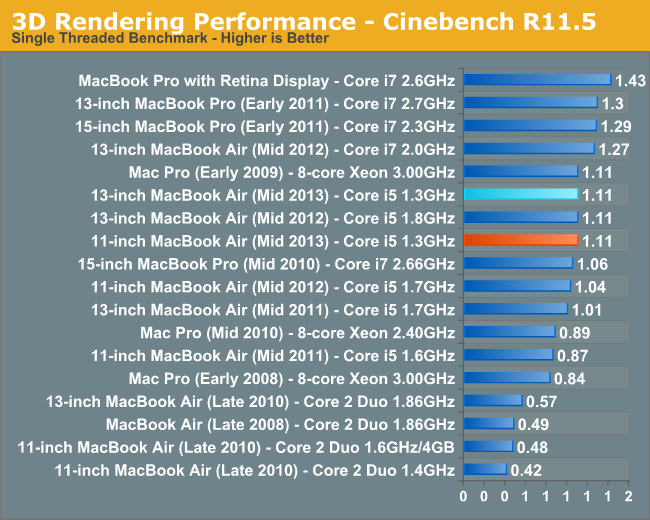
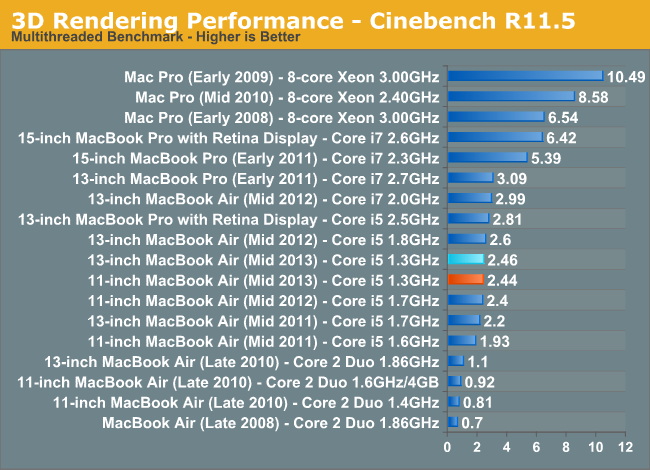 With that said, the raw performance isn’t really that great. The 13” Air that Anand reviewed was slower than its immediate predecessor, which used a 1.8GHz i5-3427U. The base 11” last year used an i5-3317U (1.7GHz) and that’s actually not a whole lot faster than the 11” Air I have here. The results are basically all within margin of error for the tests, so I’m content to call it basically even with last year’s model. The Air isn’t slow, but it can certainly get pokey at times. This is no different than any Ultrabook-class machine, but worth noting. Turbo and the very fast SSD keep things going smoothly in normal day-to-day tasks, but anything substantially more intensive than a browser and iTunes is going to be outside the comfort zone of a system like this.
With that said, the raw performance isn’t really that great. The 13” Air that Anand reviewed was slower than its immediate predecessor, which used a 1.8GHz i5-3427U. The base 11” last year used an i5-3317U (1.7GHz) and that’s actually not a whole lot faster than the 11” Air I have here. The results are basically all within margin of error for the tests, so I’m content to call it basically even with last year’s model. The Air isn’t slow, but it can certainly get pokey at times. This is no different than any Ultrabook-class machine, but worth noting. Turbo and the very fast SSD keep things going smoothly in normal day-to-day tasks, but anything substantially more intensive than a browser and iTunes is going to be outside the comfort zone of a system like this.
Considering the power efficiency though, getting similar performance to the old model even with 30% slower base clocks is a decent bargain, particularly when accounting for the increase in GPU and storage performance. I’m not going to go too far into those, since Anand did a really deep dive in his 13” Air review. It’s worth noting that while his Air had a Samsung SSD, the supplier lottery churned out a SanDisk SSD in my unit. The switch to PCIe SSDs really does make itself felt in day to day use, particularly in sleep/wake situations, as well as when launching particularly large applications (that then crawl their way through the power-sipping i5 ULT). I honestly didn’t expect that, given how accustomed I’ve become to the responsiveness of fast SSDs in general, but it’s pretty important to the MacBook Air simply in terms of keeping the system feeling quick to the touch.
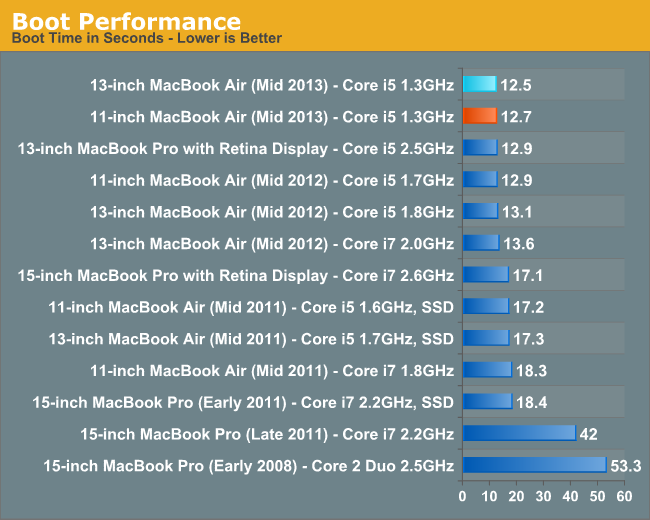

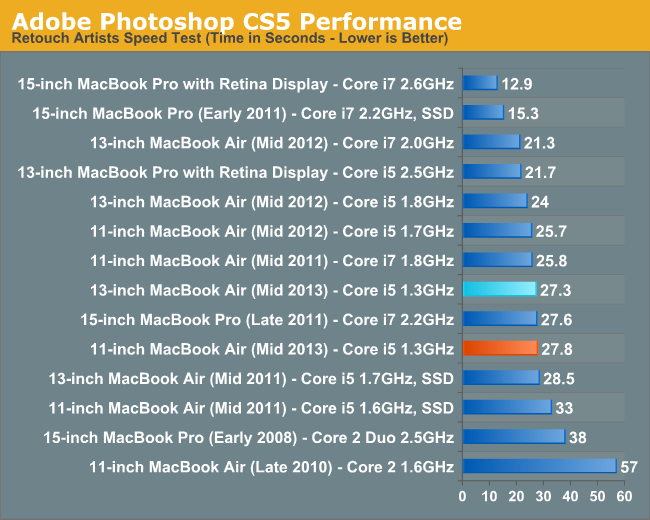


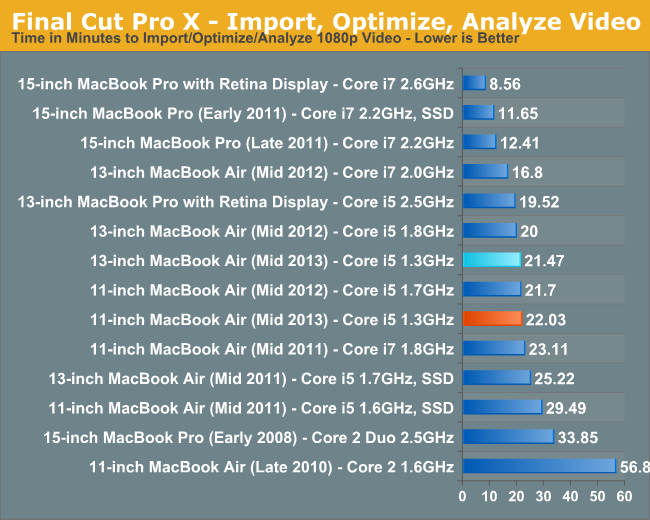










139 Comments
View All Comments
chrnochime - Friday, August 9, 2013 - link
Bezel size the same as the Vaio Pro. Sticking point is TN panel.1195-1050=145. 145/1195= 0.1213, or 12.13%, NOT 25%. Nice math genius.chrnochime - Friday, August 9, 2013 - link
And you're comparing a FP body with a CF body. Amazing.name99 - Saturday, August 10, 2013 - link
The bezel will go, and the screen size MAY increase to use up the extra space, when the retina displays are ready. Until that point, it makes no sense to make the change.This is one of (of course far from the only) the reasons Apple makes a profit --- they don't screw around with pointless modifications to something that works. You see a similar pattern in the way they have reused and repurposed the A5 CPU across their iOS line.
Compare with the Asian companies, which change chassis and internal components every three months. They never get a chance to perfect anything, they're wasting money on constant retooling and driver writing, and if you get a buggy device, it's kindof random whether the bug will ever be fixed or not.
IanCutress - Friday, August 9, 2013 - link
1.3 GHz DC 256GB 13" MBA is £1139. Vaio Pro 13 with battery slice, 1.8 GHz, 256GB, 1080p, 8gb RAM, £1130, and if I go into a shop, 3% discount. That's the challenge.abazigal - Friday, August 9, 2013 - link
MBA comes with OSX and access to the apple ecosystem, plus iLife suite and a host of other useful software features. Apple also tends to have better after-sales service.For me, I have learnt that specs alone don't always paint the full, complete picture.
ananduser - Friday, August 9, 2013 - link
You can add the downside to that as well. It doesn't come with W8 and last time I checked, a win license is not cheap. That and the relatively poor bootcamp performance(half the battery).ESC2000 - Saturday, August 10, 2013 - link
Um for a lot of people the fact that it comes with OSX is a downside. I've been considering a Mac but I'd have to bootcamp Windows because my firm requires Windows, like pretty much every large company/firm, and I dislike OSX regardless of my job's requirements. That means i'd have to pay extra for a windows license.It is true that similarly-specced Windows machines cost about the same (although I doubt we would see such a crappy screen being passed off as premium) but those OEMs are also paying for the windows license. The bottom line is Macs are overpriced. There is a reason they have $150 billion in the bank.
Every time I start thinking about buying an apple product and I look into what they offer, I always come away feeling like I would be ripped off if I bought it: either it is overpriced or some corner was cut, like the terrible air screen this year, or it lacks some software feature (in the case of the ios).
I have no idea what iLife is but I hope it is worth all that extra money.
andykins - Saturday, August 10, 2013 - link
Argument about cost of Windows is moot. Developing your own OS is neither cheap nor easy.teiglin - Friday, August 9, 2013 - link
That 1130 is with VAT? I guess UK is getting even better sales than here--that config currently runs $1680 less $100 rebate, before sales tax. So for me, that'd be a little over $1700 after cashing the rebate.Anyway, definitely the vaio, or wait for rMBP. 1440x900 may not be as awful as 1366x768 but why in god's name would you be willing to suffer a TN panel in 2013? And the vaio is freakishly light; that extra .6lbs is really easy to feel when you're holding the thing.
8steve8 - Friday, August 9, 2013 - link
I'm a MBA 13 has well owner who has been disappointed with the 11 for years now... 16:9 is a terrible aspect ratio for this kind of system, also this system has a huge bezel relative to its size, I'd love the mba11 formfactor with a 12.5 16:10 screen with a tiny bezel.